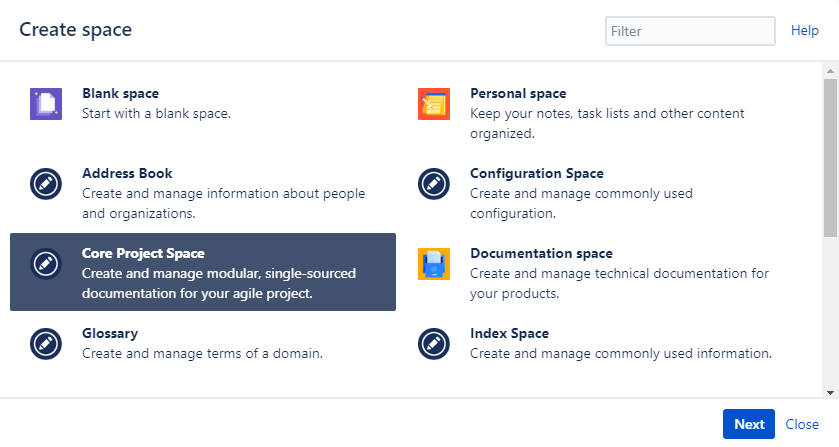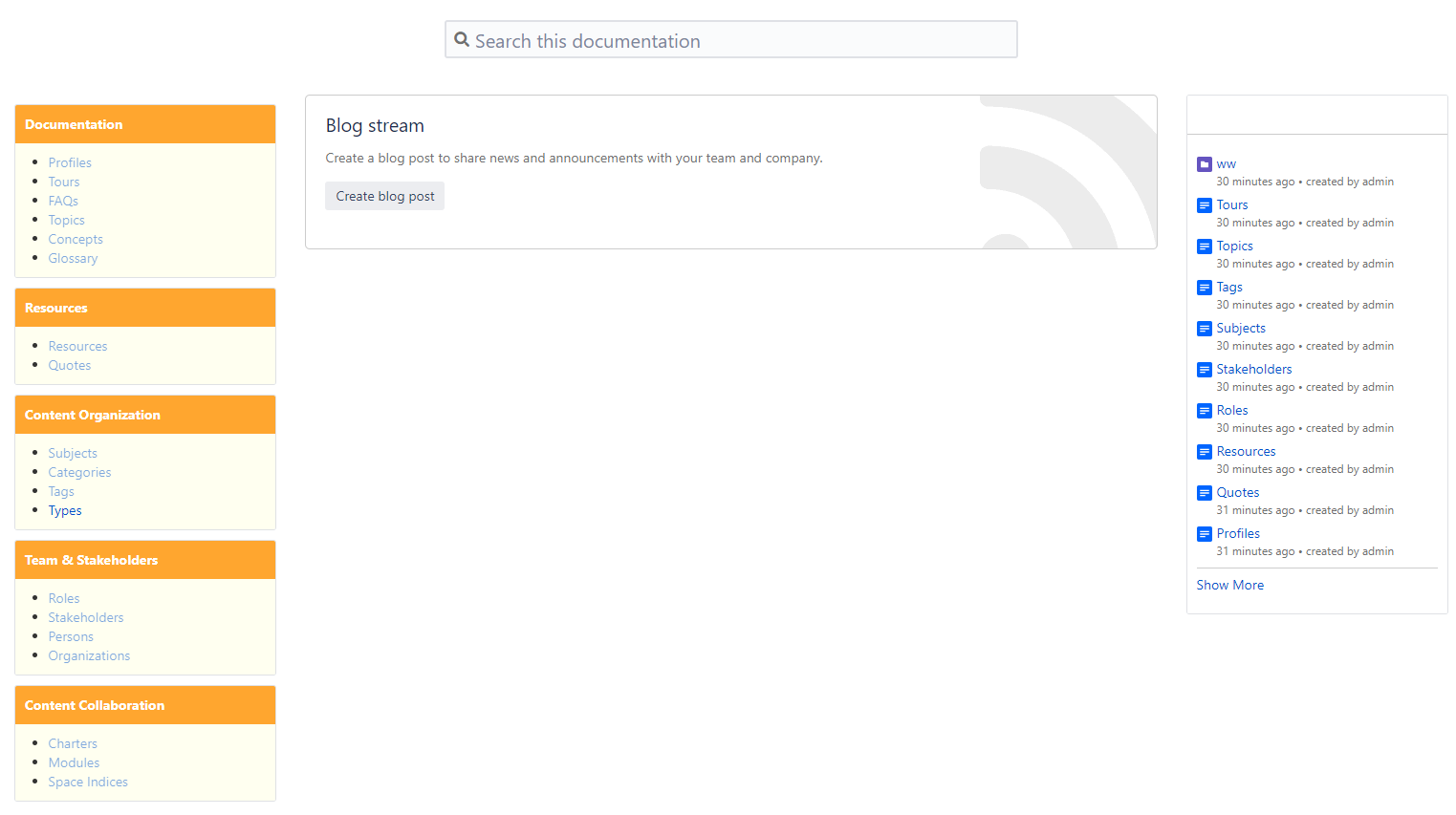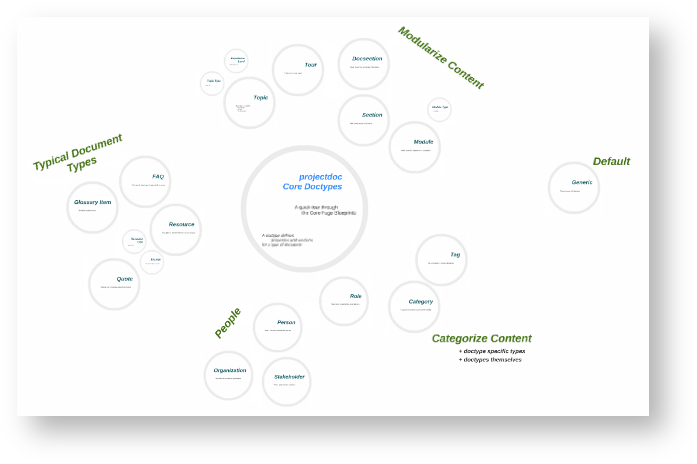- Created by Robert Reiner, last modified on 22. May 2023
projectdoc Toolbox
Doctypes define properties and sections for documents. They are essentially Confluence Blueprints that help to create pages in your wiki based on templates.
Doctypes help authors to add their information in a uniform way. This uniform way support the authors to concentrate on the content and not be distracted by formatting or coarse structuring issues. It also helps readers to find the information more quickly.
Teams should only write documentation that is essential and valueable
Templates are only a tool. If the information demands it, authors are free to add or adapt the templates to their needs. It is the ease of accessing information that counts, not the adherence to standards.
Please keep in mind to discuss deficiencies with your team members and documentation architects to continuously improve the documentation structure and tools.
Keep your documentation essential, valuable and write it just-in-time!
We assembled some quotes according to documentation writing on the projectdoc homepage. Get inspired on how to design your project documentation!
Doctypes are implemented as page blueprints, which Confluence allows to adjust to your needs. Teams should decide what elements are worthy to use and which should be discarded. After all there must be a return of investment and every asset, which includes documents, is also a (potential) liability.
To get you started with projectdoc quickly we recommend to install the Core Doctypes. With this basic set of blueprints you may start spaces to document topics that are relevant for your team. We also provide (and plan to provide) additional doctype add-ons for other areas of project documentation.
Have a look at the doctype add-ons that are already available on the Atlassian Marketplace!
The projectdoc Add-on provides only a demonstration space and the Blank Document doctype.
Related Documentation
The following links direct you to related documentation within this wiki.
English and German by Default
All doctype add-ons are available in English and German language (except for the V-Modell XT add-on for which only German is supported).
For more information on this topic please refer to Localization.
Create a Space
To get started with the Core Doctypes, we recommend to create an Core Project Space.

This provides the basic structure to add new documents easily by the use of home and index pages. This is how the space looks like:

If you prefer to start with a relatively blank space, consider to choose the Configuration Space. It creates a home page and an index page for type documents.
List of Space Blueprints
The following space blueprints are provided by the Core Doctypes.
- Address Book
Manage information about people and their roles and interests in a product or project. This space contains information about roles, persons, and organizations.
- Configuration Space
Manage commonly used configurations without any subdocuments (besides a homepage for type homepages).
- Core Project Space
Create a space to organize information for your agile team. A basic structure with homepages is created, such as for tags, topics, or roles).
- Glossary
Manage information about a domain. Add glossary items and associate them with domain information.
- Index Space
Collect commonly used information like spaces properties or type documents. You may also include fragments to be used by transclusion or other information that is relevant for all dependent spaces.
- Library
Manage information about resources. This includes books, articles, podcasts, as well as information about the authors of these resources.
- Topic Space
- Create a space to collect and organize information on a topic.
- Workspace
Create a space to collaboratively collect information on a specific topic. A workspace does not demand for updating information. It is a place to work with until a goal is reached. Move the result of your research to topic spaces and discard or archive this space.
Core Doctypes
The following document types are part of the Core Doctypes Add-on.
You may also take an alternative introduction to the Core Doctypes by a Prezi presentation. The presentation provides a good overview by grouping closely related doctypes.
The core doctypes provide the base for your agile documentation work. You may also use them as an inspiration for designing your own templates that meet exactly the requirements of your project.
Please refer to Tour for Document Authors for an introduction on how to use these templates and to Tour for Template Authors for information on how to design your own templates.
| # | Name | Short Description | Categories |
|---|---|---|---|
| 1 | Association | Associates two documents. | / Document / Part |
| 2 | Association Type | Categorize associations by a type. | / Organisation / Specific |
| 3 | Category | Categories allow to set document instance of different doctypes in a hierarchy. | / Organisation / Generic |
| 4 | Category Type | Categorize categories by a type. | / Organisation / Specific |
| 5 | Charter | Describes an information need and use this description as a basis to create and maintain a document. | / Work / Unit |
| 6 | Charter Type | Categorize charters by a type. | / Organisation / Specific |
| 7 | Excerpt | Excerpts are abstracts of information found in a resource, such as a book. If you want to go into more detail for a given resource, there may be multiple excerpts as subpages of the resource document. | / Document / Part |
| 8 | Excerpt Type | Categorize excerpts by a type. | / Organisation / Specific |
| 9 | Experience Level | Defines the context through which readers acquire skills. The level sets the expectation on the author's techniques to teach. | / Organisation / Specific |
| 10 | Experience Level Type | Categorize experience levels by a type. | / Organisation / Specific |
| 11 | FAQ | FAQs help to record an answer to a frequently asked question concerning the project, the product, the system or the process. | Documentation |
| 12 | FAQ Type | Categorize FAQs by a type. | / Organisation / Specific |
| 13 | Generic | Generic Documents provide information where no other doctype matches. | / Document / Entity |
| 14 | Generic Type | Categorize generic documents by a type. | / Organisation / Specific |
| 15 | Glossary Item | Glossary items are part of the domain glossary for the project. Glossaries support the team to use terms of the domain consistently in conversations and documentation. | / Document / Entity |
| 16 | Glossary Item Type | Categorize glossary items by a type. | / Organisation / Specific |
| 17 | Media Type | Resources are identified by their media type. This may be the MIME type, but also a human readable string, that identifies the syntactic format. | / Organisation / Specific |
| 18 | Media Type Type | Categorize media types by their type. | / Organisation / Specific |
| 19 | Metadata | Metadata documents provide tables of simple key/value pairs. This information can be used as an aspect or as additional space properties to be available for reference on your wiki. | / Document / Data |
| 20 | Metadata Type | Categorize metadata documents by a type. | / Organisation / Specific |
| 21 | Module | A documentation module is a fragment which is usually transcluded by other documents. The lifetime of a module document is independent of the lifetimes of the documents that reference it. | / Document / Entity |
| 22 | Module Type | Categorization of document modules for single sourcing. | / Organisation / Specific |
| 23 | Organization | Information about organizations that take a part in the project. You may collect common information here for all persons that belong to an organization, such as address or homepage. | / Team |
| 24 | Organization Type | Categorize organizations by a type. | / Organisation / Specific |
| 25 | Person | Provides information about a person. This includes contact information (important if the person is relevant for the team) or information about the competences (if the person is an author about a topic relevant for the project). | / Team |
| 26 | Person Type | Categorize persons by a type. | / Organisation / Specific |
| 27 | Profile | Profiles provide views on documents via delegation. | / Document / Part |
| 28 | Profile Type | Categorize profiles by a type. | / Organisation / Specific |
| 29 | Quote | Quotes relevant for the project. Allows to store the content and metadata to the quote. | / Document / Entity |
| 30 | Quote Type | Categorize quotes by a type. | / Organisation / Specific |
| 31 | Relation | Organizes glossary items. | / Organisation / Specific |
| 32 | Relation Type | Categorize relations by a type. | / Organisation / Specific |
| 33 | Resource | Resources are books, webpages, videocasts relevant for the project. Add important information to your project about resources that lie outside the control of your team. | / Document / Entity |
| 34 | Resource Type | Resources are identified by their type. This is not the MIME type, but human readable string, that identifies the semantic, rather than the syntactic format. | / Organisation / Specific |
| 35 | Role | Defines a role with its responsibilities, tasks and requirements. Roles are incorporated by stakeholders who take interest in the project. The are also used to define the audience for documents. | / Organisation / Generic |
| 36 | Role Type | Categorize roles by a type. | / Organisation / Specific |
| 37 | Section | Sections of a document are typically part of a document. But the size of sections may vary. To support a team to write collaboratively on the documentation, a larger document may be subdivided into external section documents. | / Document / Part |
| 38 | Section Type | Categorize sections by a type. | / Organisation / Specific |
| 39 | Space Index | Compile other documents, yet space indices are themselves projectdoc documents. So they can be tagged and grouped. | / Organisation / Space |
| 40 | Space Index Type | Categorize space indexes by a type. | / Organisation / Specific |
| 41 | Stakeholder | A party that takes interest in a project. The stakeholder is either a real person, an organization or group, or represents a class of individuals, groups or organizations. | / Team |
| 42 | Stakeholder Type | Categorize stakeholders by a type. | / Organisation / Specific |
| 43 | Step | Describes a single step of an activity. A step is a generic document that is associated with a document that describes a process. It may be a test log or a howto. | / Document / Part |
| 44 | Step Type | Categorize steps by a type. | / Organisation / Specific |
| 45 | Subject | Subject documents allow to set document instance of different doctypes in a common context. | / Organisation / Generic |
| 46 | Subject Type | Categorize subjects by a type. | / Organisation / Specific |
| 47 | Tag | Document the semantics of a tag. May also be used to document Confluence labels. | / Organisation / Generic |
| 48 | Tag Type | Categorize tags by a type. | / Organisation / Specific |
| 49 | Topic | A description of a given topic. A topic may describing or explaining a concept, a task to accomplish or a reference. There are a couple of topic types that set the expectations for the reader. Instances of the topic doctype usually have independent lifetimes from any referencing documents. | / Document / Entity |
| 50 | Topic Type | A topic type is a semantic type of the topic. It helps to set the expectations of potential readers. | / Organisation / Specific |
| 51 | Tour | Guided tours through existing information. This allows to aggregate topics for a given question or audience, thus providing a view on a topic. | / Document / Aggregate |
| 52 | Version | Document a version of a product or service. | / Document / Data |
| 53 | Version Type | Categorize versions by a type. | / Organisation / Specific |
Find more doctypes in the extensions!
Extension Doctypes
The following doctypes are not part of the Core Doctypes Add-on, but are (or will soon be) available in separate packages.
Separate add-ons make it easy for teams to select those doctypes that are useful for them and their specific project requirements.
Please make sure to check those extension doctypes. Maybe they are not provide exactly to what you require, but they can be a good starting point.
For minor changes Confluence allows to adjust the templates easily. For larger changes we recommend to create a blueprint project and build your own add-on. If you have developers on your team, this may be much easier than you think. Please refer to Tour for Template Authors for an overview on how to do this. We plan to release some of our doctype projects on GitHub to make you get started with your own add-on extensions more quickly.
| Name | Status | Short Description |
|---|---|---|
| Doctypes for Software Development | AVAILABLE | Provides doctypes to create documentation in software development projects. The focus is on documenting the architecture of the product, but it includes templates for other software development documentation requirements as well. |
| projectdoc Add-on for arc42 | AVAILABLE | Provides doctypes to document a system or software architecture based on the arc42 Template. |
| Doctypes for Agile Planning | AVAILABLE | Provides doctypes to collborate with your team. Run iterations and record discoveries that may be of interest at the end of the iteration or for even later reference. Quick notes are more easily added as records to the team's space than to the official documentation tree. Defer the talk to the documentation architect to the end of the iteration (if the discovery is still of interest). |
| projectdoc Developer Diaries | AVAILABLE | Provides doctypes to organize the developer's work by the employment of a diary. Take you personal planning and professional records to the next level! |
| projectdoc for Java Developers | AVAILABLE | A collection of blueprints for Confluence to create and work with documentation for Java projects. |
| projectdoc for Maven Developers | AVAILABLE | A collection of blueprints for Confluence to create and work with documentation for Maven projects. |
| Doctypes for Teamwork | AVAILABLE | Provides doctypes to define the checklists, processes, patterns, tools, and rules your team agrees upon. Writing them down makes them accessible for anyone - especially for new team members. Keep these documents short and to the point! |
| Doctypes for Business Strategy | AVAILABLE | Mission, vision, strategy for business planning and execution. |
| Doctypes for Service Management | AVAILABLE | Provides doctypes to document services and systems for IT service management (ITSM). |
| Doctypes for Project Management | AVAILABLE | Provides doctypes for documenting decisions, risks, open issues, and meeting minutes. |
| Doctypes for Risk Management | AVAILABLE SOON | Provides doctypes for documenting and tracking risks. |
| Doctypes for App Manuals | AVAILABLE SOON | Document macros, page blueprints, space blueprints, and components of your Confluence add-on. |
| Doctypes for V-Modell®XT | AVAILABLE | Use products (templates) from the V-Modell®XT in your Confluence wiki as blueprints! |
| Doctypes for Conversation, Feedback, Recognition | POSTPONED | Use CFRs to implement continuous performance management in your wiki. |
| Impact Mapping | POSTPONED | Analyse the impact you can make. |
| Lean | POSTPONED | State assumptions and hypotheses to run your experiments. Document your output and plan for outcome and impact. |
| Objectives and Key Results | POSTPONED | Use OKRs to define your objectives and focus on your key results. |
Some doctype and extension add-ons are currently still under development. They will be available for download on the Atlassian Marketplace soon.
Add-ons labelled as AVAILABLE SOON are already published on Bitbucket.
ABOUT TO BE AVAILABLE indicates that the add-on has been released to the Atlassian Marketplace and is waiting for approval.
Add-ons with status AVAILABLE are published on the Atlassian Marketplace and on Bitbucket.
Add-ons marked as NOT YET PUBLISHED are currently under development. Please get in touch if you need to know about the release plan!
POSTPONED indicates that the add-on is no longer under active development to be released on the Atlassian Marketplace, but still available on Bitbucket.
Resources
- Document Types and Templates
- Document types (or doctypes for short) define a set of properties and sections. Each doctype matches at least one Confluence Page Blueprint. Confluence Page Blueprints are a collection of templates, but often the collection contains only one element.
- Doctypes Overview
- List of all doctypes provided by add-ons. Provides an overview over doctype IDs and blueprint keys.
- projectdoc Toolbox Online Manual
- The online manual for version 1 of the projectdoc Toolbox for Confluence.
- Think Repositories
- To organize your documentation place documents in a typed repository and add additional views on demand.
- Topic is not meant to be multi-purpose
- Despite the name of the Topic Doctype, it is not supposed to be used for any topic. Use the Generic Doctype or the Section Doctype for general purposes.








